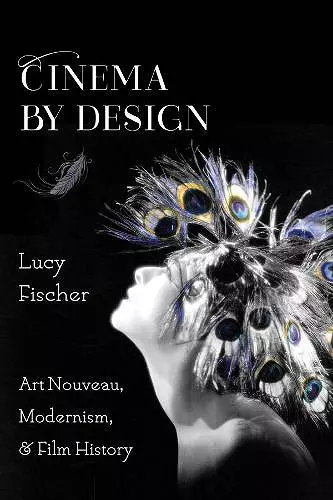Cinema by Design
Art Nouveau, Modernism, and Film History
Format:Paperback
Publisher:Columbia University Press
Published:24th Mar '17
Currently unavailable, and unfortunately no date known when it will be back

?In Cinema by Design, Lucy Fischer traces Art Nouveau's long history in films from various decades and global locales, appreciating the movement's enduring avant-garde aesthetics and dynamic ideology. Fischer's analysis brings into focus the partnership between Art Nouveau's fascination with the illogical and the unconventional and filmmakers' desire to upend viewers' perception of the world. Her work explains why an art movement embedded in modernist sensibilities can flourish in contemporary film through its visions of nature, gender, sexuality, and the exotic.
Cinema by Design traces Art Nouveau’s long history in films from various decades and global locales, appreciating the movement’s enduring avant-garde aesthetics. Lucy Fischer explains why an art movement embedded in modernist sensibilities can flourish in contemporary film through its visions of nature, gender, sexuality, and the exotic.Art Nouveau thrived from the late 1890s through the First World War. The international design movement reveled in curvilinear forms and both playful and macabre visions and had a deep impact on cinematic art direction, costuming, gender representation, genre, and theme. Though historians have long dismissed Art Nouveau as a decadent cultural mode, its tremendous afterlife in cinema proves otherwise. In Cinema by Design, Lucy Fischer traces Art Nouveau's long history in films from various decades and global locales, appreciating the movement's enduring avant-garde aesthetics and dynamic ideology. Fischer begins with the portrayal of women and nature in the magical "trick films" of the Spanish director Segundo de Chomon; the elite dress and decor design choices in Cecil B. DeMille's The Affairs of Anatol (1921); and the mise-en-scene of fantasy in Raoul Walsh's The Thief of Bagdad (1924). Reading Salome (1923), Fischer shows how the cinema offered an engaging frame for adapting the risque works of Oscar Wilde and Aubrey Beardsley. Moving to the modern era, Fischer focuses on a series of dramatic films, including Michelangelo Antonioni's The Passenger (1975), that make creative use of the architecture of Antoni Gaudi; and several European works of horror-The Abominable Dr. Phibes (1971), Deep Red (1975), and The Strange Color of Your Body's Tears (2013)-in which Art Nouveau architecture and narrative supply unique resonances in scenes of terror. In later chapters, she examines films like Klimt (2006) that portray the style in relation to the art world and ends by discussing the Art Nouveau revival in 1960s cinema. Fischer's analysis brings into focus the partnership between Art Nouveau's fascination with the illogical and the unconventional and filmmakers' desire to upend viewers' perception of the world. Her work explains why an art movement embedded in modernist sensibilities can flourish in contemporary film through its visions of nature, gender, sexuality, and the exotic.
Cinema by Design uncovers the hitherto marginalized influence of Art Nouveau on cinema and adds to Lucy Fischer's already impressive work on the mutual influence of cinema and the arts. Drawing on key moments in the history of art and architecture, and putting them up against episodes in film and film theory, Fischer shows how Art Nouveau often served a visual style that could be used to convey various associations, not only aesthetic but also political. Cinema by Design is a compelling, erudite account that provides not only a new path into the interweaving of cinema and the arts but also a demonstration of how a cross-media influence functions as a building of film style and meaning. -- Daniel Morgan, University of Chicago Lucy Fischer rescues Art Nouveau from the taint it suffered as excessive, horrific, and degenerate, detailing its unique styles, themes and tropes; its uses of nature; its links to modernism and cinema history, as well as the way it energized new art forms for more than a century. A trove of brilliant interconnections amongst cinema and the arts, Cinema by Design will both entertain and inform. -- E. Ann Kaplan, Stony Brook University A leading scholar in so many fields within cinema and media studies, Lucy Fischer demonstrates and celebrates here-intellectually and passionately-a topic that she owns: the architectural and design world of cinematic art nouveau. -- Timothy Corrigan, coeditor of Essays on the Essay Film Lucy Fischer significantly realigns much of what we know about design in cinema by offering an illuminating account of Art Nouveau as an international style devoted to aesthetic display, visual excess, and sensory gratification. Often considered the first modernist movement, Art Nouveau celebrated natural beauty and sensuality, but did not reject modernity or industry. Instead, as Fischer so persuasively shows, it endeavored to merge industry with art and thus to re-enchant the world by augmenting industrial, scientific reality with beauty, sensuality, mystery, and pleasure. Cinema by Design is a brilliant work of film history. -- Patrice Petro, University of California at Santa Barbara
- Short-listed for Kraszna-Krausz Foundation, Kraszna-Krausz Book Award for Best Moving Image Book 2018
ISBN: 9780231175036
Dimensions: unknown
Weight: unknown
288 pages